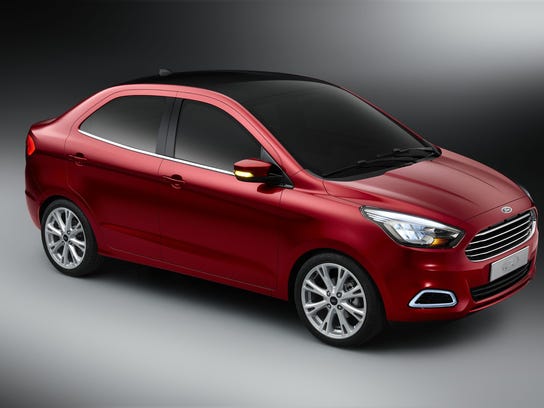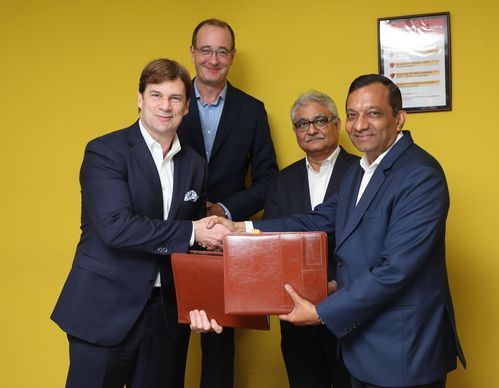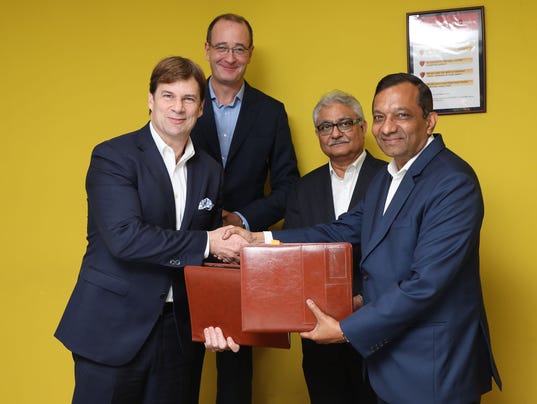Pankaj Radhe, Special to the Free Press Published 6:00 a.m. ET April 6, 2018 | Updated 9:55 a.m. ET April 6, 2018
From left to right: Jim Farley, Ford executive vice president and president of Global Markets, Peter Fleet, Group vice president & president, Ford Asia Pacific with Rajan Wadhera, president, automotive sector and Pawan Goenka, Managing Director, Mahindra and Mahindra Ltd. The two companies will jointly develop new SUVs, and a small electric vehicle as part of several initiatives it was announced March 22, 2018.
(Photo: Ford Motor Company)
NEW DELHI — Ford is reviving old partnerships in India as the company makes a fresh pitch to crack one of the world’s highest potential, but equally challenging car markets.
Having invested $2 billion but yet to make profits, the company has gone back to local heavyweight Mahindra & Mahindra to work out new products and partner on cost-effective technologies, including those related to electric powertrains.
Ford, whose sales in India have risen in recent months year over year, holds just a 2.7 percent market share. The company hopes that Mahindra will help it gain access to local suppliers while enabling cost-efficient development of vehicles, especially SUVs.
Read more:
Ford entered India in 1995 and partnered with Mahindra — then itself a fledgling player in the passenger vehicle business — though this was short-lived. The two parted ways in 1998, as Ford drew up an ambitious plan, perhaps looking to find a stronger-run standalone as it also planned to use the India factories for meeting export needs.
However, Ford has managed little success and has remained — more or less — a two-car wonder in the Indian market. The Figo compact, launched in 2010 after an in-depth examination of the Indian consumer, was the first vehicle that got Ford into the heart of buyers. Figo managed to capture the fancy of the very-choosy local buyer, and was even successful in snatching market-share from the highly competitive Maruti (the local subsidiary of Japan’s Suzuki) and Hyundai, the country’s top two makers.
However, the success did not last, and Ford failed to repeat the same story with the subsequent products.
Now, it’s decided to continue seeking a foothold in the tough market, where General Motors abandoned efforts last year. The potential reward is strong. India is expected to surpass Japan within a few years as the world’s third-largest vehicle market, and sales are projected to double to 6 million a year.

Ford EcoSport, Goa, India in 2013.
(Photo: Ford Motor Company)
EcoSport success
A turning point in the company’s India story came in the middle of 2013 when it launched the EcoSport, a mini SUV that once again managed to lure buyers into Ford showrooms, prompting the company to set up a new factory and double investment.
However, competitors have started hitting the segment hard – Maruti drove in the Vitara Brezza mini SUV and Hyundai the Creta.
Ford has now decided that a strong local partner that would help in realizing India’s famed frugal engineering may be its answer.
With Mahindra, Ford has struck a partnership for budget electric vehicles and SUVs. The deal follows an announcement in September 2017 in which the companies agreed to explore strategic cooperation for driving what they called profitable growth in India and other emerging markets.
In late March, the companies signed multiple memoranda of understanding to firm up plans that envisage joint vehicle development, while also looking at technology development and solutions around connected cars and vehicle safety.
For Mahindra, the renewed partnership with Ford follows a failed relationship that it had with France’s Renault that was dissolved in 2010.
Ford’s agreement with Mahindra comes as the company looks at budget electric-vehicle technologies and access to affordable suppliers. The Indian government has said that it wants companies to transition to electric vehicles by 2030 as it announces large orders for the clean vehicles in the intervening period.
For its part, the Mahindra group is seeking refinement and help in the area of vehicle development from Ford, especially when it comes to off-roaders, while also looking at cooperation in effectively targeting markets in Africa and other export regions.
Carefully selected executives from the two companies have been working on the joint efforts for the last few months. Mahindra’s negotiator was Managing Director Pawan Goenka while Jim Farley, president of global markets, represented Ford.
“Ford is committed to offering the best vehicles, technologies and services that fit the lifestyles and preferences of Indian consumers,” Farley said. “Listening to our customers and incorporating their future needs is the core premise of this collaboration. With utility vehicles and electrification as key focus areas, we are glad to see the progress our two companies have made.”
Mahindra’s Goenka called it “the next step in collaboration” between the two companies. “Both teams are working together on joint development areas in keeping with industry requirements and leveraging mutual strengths. We are excited about the synergies unveiled through this collaboration and the potential opportunities it will bring.”
Midsize SUV ahead
Ford and Mahindra said that they will co-develop a midsize sport utility vehicle that would later be sold under their individual badges. “Built on the Mahindra platform, the new SUV will drive engineering and commercial efficiencies and will be sold independently by both companies as separate brands,” the companies said.
Also on the agenda are plans to evaluate codevelopment of a compact SUV as well as an electric vehicle. It is believed that Mahindra has helped Ford develop an electric version of the Aspire mini sedan that it sells in India. Ford is understood to be looking at launching the vehicle in India next year, while it is yet not clear whether it also plans to export it to other markets.

The Ford Figo Aspire will be the first vehicle produced at the new plant. The Figo has single-handedly created awareness of the Ford brand.
(Photo: Ford)
Ford and Mahindra have also decided to explore the sharing of powertrain portfolios. The American company is looking at sourcing Mahindra powertrains for use on its product range, something that will help the companies attain economies of scale and price the vehicles more competitively.
Mahindra will be looking to learn a lot from Ford when it comes to refinement of products and their development. The company has been one of India’s top utility vehicle sellers, but is now increasingly facing intense competitive pressure.
Maruti Suzuki has been launching new SUVs in line with their growing popularity with buyers. Other companies such as Hyundai, Renault and homegrown Tata Motors are also launching new off-roaders. This has put an intense pressure on Mahindra, which is now looking to modernize its portfolio.
Anand Mahindra, the chairman of the Mahindra group, has said “there will be much more collaboration between auto companies going forward,” including the partnership with Ford and American shared mobility company Scoot.
Teams from both companies will be working together for up to three years as they develop further avenues of cooperation. These would include extending support for Mahindra in global emerging markets, including possible access to Ford’s manufacturing and distribution network.
Also, the companies will look at collaboration in trying to address future mobility needs. These would be deployed on products from both the companies.
Read or Share this story: https://on.freep.com/2GDYphu

